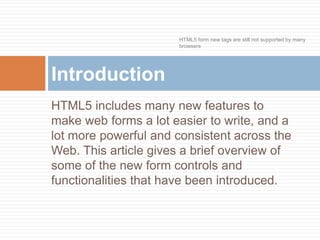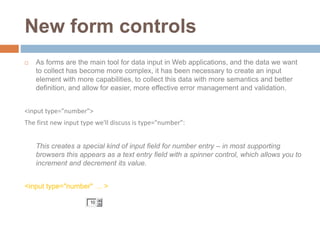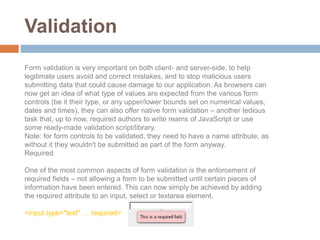html 5 new form attribute
- 1. FORMS WITH HTML5 HTML5 form additions
- 2. HTML5 includes many new features to make web forms a lot easier to write, and a lot more powerful and consistent across the Web. This article gives a brief overview of some of the new form controls and functionalities that have been introduced. Introduction HTML5 form new tags are still not supported by many browsers
- 3. HTML5 New Form Attributes New attributes for <form>: autocomplete novalidate New attributes for <input>: autocomplete autofocus form formaction formenctype formmethod formnovalidate formtarget height and width list min and max multiple pattern (regexp) placeholder required step HTML5 has several new attributes for <form> and <input>.
- 4. New form controls As forms are the main tool for data input in Web applications, and the data we want to collect has become more complex, it has been necessary to create an input element with more capabilities, to collect this data with more semantics and better definition, and allow for easier, more effective error management and validation. <input type="number"> The first new input type we'll discuss is type="number": This creates a special kind of input field for number entry – in most supporting browsers this appears as a text entry field with a spinner control, which allows you to increment and decrement its value. <input type="number" … >
- 5. <input type="range"> Creating a slider control to allow you to choose between a range of values used to be a complicated, semantically dubious proposition, but with HTML5 it is easy — you just use the rangeinput type: <input type="range" … >
- 6. <input type="date"> and other date/time controls HTML5 has a number of different input types for creating complicated date/time pickers, for example the kind of date picker you see featured on pretty much every flight/train booking site out there. These used to be created using unsemantic kludges, so it is great that we now have standardized easy ways to do this. For example: <input type="date" … > <input type="time" … > Respectively, these create a fully functioning date picker, and a text input containing a separator for hours, minutes and seconds (depending on the step attribute specified) that only allows you to input a time value. date and time input types. But it doesn't end here — there are a number of other related input types available: datetime: combines the functionality of two we have looked at above, allowing you to choose a date and a time. month: allows you to choose a month, stored internally as a number between 1-12, although different browsers may provide you with more elaborate choosing mechanisms, like a scrolling list of the month names. week: allows you to choose a week, stored internally in the format 2010- W37 (week 37 of the year 2010), and chosen using a similar datepicker to the ones we have seen already.
- 7. <input type="color"> This input type brings up a color picker. Opera's implementation allows the user to pick from a selection of colors, enter hexadecimal values directly in a text field, or to invoke the OS's native color picker. a color input, and the native color pickers on Windows and OS X.
- 8. <input type="search"> The search input type is arguably nothing more than a differently-styled text input. Browsers are meant to style these inputs the same way as any OS- specific search functionality. Beyond this purely aesthetic consideration, though, it's still important to note that marking up search fields explicitly opens up the possibility for browsers, assistive technologies or automated crawlers to do something clever with these inputs in the future – for instance, a browser could conceivably offer the user a choice to automatically create a custom search for a specific site. The <datalist> element and list attribute Up until now we have been used to using <select> and <option> elements to create dropdown lists of options for our users to choose from. But what if we wanted to create a list that allowed users to choose from a list of suggested options, as well as being able to type in their own? That used to require fiddly scripting – but now you can simply use the list attribute to connect an ordinary input to a list of options, defined inside a <datalist> element. <input type="text" list="mydata" … > <datalist id="mydata"> <option label="Mr" value="Mister"> <option label="Mrs" value="Mistress"> <option label="Ms" value="Miss"> </datalist>
- 9. <input type="tel">, <input type="email"> and <input type="url"> As their names imply, these new input types relate to telephone numbers, email addresses and URLs. Browsers will render these as normal text inputs, but explicitly stating what kind of text we're expecting in these fields plays an important role in client-side form validation. Additionally, on certain mobile devices the browser will switch from its regular text entry on-screen keyboard to the more context-relevant variants. Again, it's conceivable that in the future browsers will take further advantage of these explicitly marked-up inputs to offer additional functionality, such as autocompleting email addresses and telephone numbers based on the user's contacts list or address book.
- 10. New attributes In addition to explicit new input types, HTML5 defines a series of new attributes for form controls that help simplify some common tasks and further specify the expected values for certain entry fields. Placeholder A common usability trick in web forms is to have placeholder content in text entry fields – for instance, to give more information about the expected type of information we want the user to enter – which disappears when the form control gets focus. While this used to require some JavaScript (clearing the contents of the form field on focus and resetting it to the default text if the user left the field without entering anything), we can now simply use the placeholder attribute: <input type="text"… placeholder="John Doe"> A text input with placeholder text.
- 11. Autofocus Another common feature that previously had to rely on scripting is having a form field automatically focused when a page is loaded. This can now be achieved with the autofocusattribute: <input type="text" autofocus … > Keep in mind that you shouldn't have more than one autofocus form control on a single page. You should also use this sort of functionality with caution, in situations where a form represents the main area of interest in a page. A search page is a good example – provided that there isn't a lot of content and explanatory text, it makes sense to set the focus automatically to the text input of the search form. Min and Max As their name suggests, this pair of attributes allows you to set a lower and upper bound for the values that can be entered into a numerical form field, for example number, range, time or date input types (yes, you can even use it to set upper and lower bounds for dates – for instance, on a travel booking form you could limit the datepicker to only allow the user to select future dates). For range inputs, min and max are actually necessary to define what values are returned when the form is submitted. The code is pretty simple and self- explanatory: <input type="number" … min="1" max="10">
- 12. Step The step attribute can be used with a numerical input value to dictate how granular the values you can input are. For example, you might want users to enter a particular time, but only in 30 minute increments. In this case, we can use the step attribute, keeping in mind that for time inputs the value of the attribute is in seconds: <input type="time" … step="1800">
- 13. Validation Form validation is very important on both client- and server-side, to help legitimate users avoid and correct mistakes, and to stop malicious users submitting data that could cause damage to our application. As browsers can now get an idea of what type of values are expected from the various form controls (be it their type, or any upper/lower bounds set on numerical values, dates and times), they can also offer native form validation – another tedious task that, up to now, required authors to write reams of JavaScript or use some ready-made validation script/library. Note: for form controls to be validated, they need to have a name attribute, as without it they wouldn't be submitted as part of the form anyway. Required One of the most common aspects of form validation is the enforcement of required fields – not allowing a form to be submitted until certain pieces of information have been entered. This can now simply be achieved by adding the required attribute to an input, select or textarea element. <input type="text" … required>
- 14. Type and pattern As we've seen, authors can now specify the kinds of entries they expect from their form fields – rather than simply defining text inputs, authors can explicitly create inputs for things like numbers, email addresses and URLs. As part of their client-side validation, browsers can now check that what the user entered in these more specific fields matches the expected structure – in essence, browsers evaluate the input values against a built-in pattern that defines what valid entires in those types of inputs look like, and will warn a user when their entry didn't match the criteria. For other text entry fields that nonetheless need to follow a certain structure (for instance, login forms where the usernames can only contain a specific sequence of lowercase letters and numbers), authors can use the pattern attribute to specify their own custom regular expression. <input type="text" … pattern="[a-z]{3}[0-9]{3}">
- 15. On the desktop, Opera currently has the most complete implementation of new input types and native client-side validation, but support is on the roadmap for all other major browsers as well, so it won't be long before we can take advantage of these new powerful tools in our projects. But what about older browser versions? By design, browsers that don't understand the new input types (like date or number) will simply fall back to treating them as standard text inputs – not as user- friendly as their advanced HTML5 counterparts, but at the very least they allow for a form to be filled in. Browser support













![Type and pattern
As we've seen, authors can now specify the kinds of entries they expect from
their form fields – rather than simply defining text inputs, authors can
explicitly create inputs for things like numbers, email addresses and URLs. As
part of their client-side validation, browsers can now check that what the user
entered in these more specific fields matches the expected structure – in
essence, browsers evaluate the input values against a built-in pattern that
defines what valid entires in those types of inputs look like, and will warn a
user when their entry didn't match the criteria.
For other text entry fields that nonetheless need to follow a certain structure
(for instance, login forms where the usernames can only contain a specific
sequence of lowercase letters and numbers), authors can use
the pattern attribute to specify their own custom regular expression.
<input type="text" … pattern="[a-z]{3}[0-9]{3}">](https://image.slidesharecdn.com/formswithhtml5-160328100040/85/html-5-new-form-attribute-14-320.jpg)
